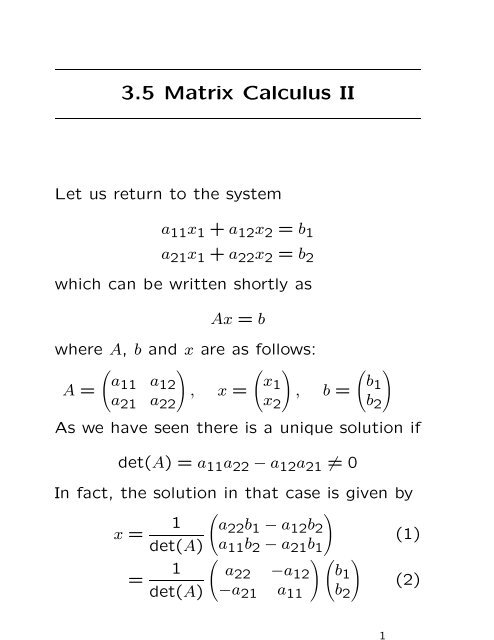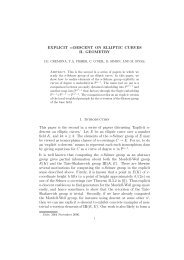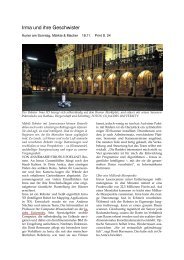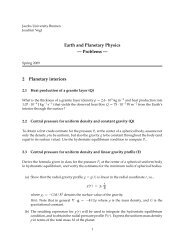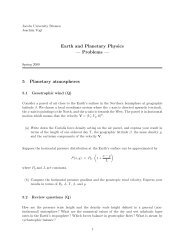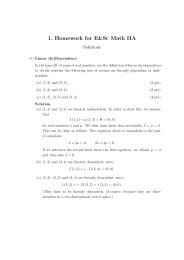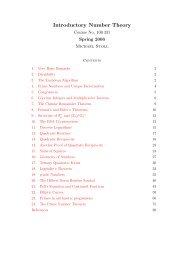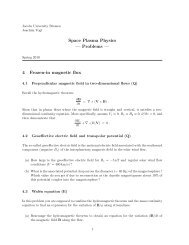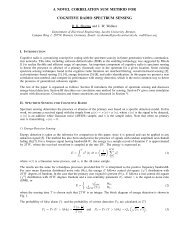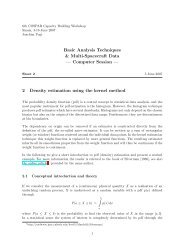A4 - Faculty.jacobs-university.de
A4 - Faculty.jacobs-university.de
A4 - Faculty.jacobs-university.de
Create successful ePaper yourself
Turn your PDF publications into a flip-book with our unique Google optimized e-Paper software.
3.5 Matrix Calculus II<br />
Let us return to the system<br />
a11x1 + a12x2 = b1<br />
a21x1 + a22x2 = b2<br />
which can be written shortly as<br />
Ax = b<br />
where A, b and x are as follows:<br />
A =<br />
<br />
a11<br />
<br />
a12<br />
a21 a22<br />
, x =<br />
<br />
x1<br />
x2<br />
, b =<br />
<br />
b1<br />
b2<br />
As we have seen there is a unique solution if<br />
<strong>de</strong>t(A) = a11a22 − a12a21 = 0<br />
In fact, the solution in that case is given by<br />
x =<br />
=<br />
1<br />
<strong>de</strong>t(A)<br />
1<br />
<strong>de</strong>t(A)<br />
<br />
<br />
a22b1 − a12b2<br />
a11b2 − a21b1<br />
<br />
<br />
a22 −a12 b1<br />
−a21 a11 b2<br />
1<br />
(1)<br />
(2)
3.5 Matrix Calculus II<br />
Now it is tempting to multiply the matrix<br />
equation Ax = b by a matrix A −1 such that<br />
x = A −1 Ax = A −1 b<br />
If we compare this with (1) and (2) then it<br />
follows that<br />
A −1 =<br />
1<br />
<strong>de</strong>t(A)<br />
<br />
<br />
a22 −a12<br />
−a21 a11<br />
We have A −1 A = AA −1 = E, that is, A has<br />
an inverse matrix. For <strong>de</strong>t(A) = 0 there<br />
does not exist an inverse matrix for A. The<br />
<strong>de</strong>finition of an invertible matrix is as follows:<br />
Definition (Non-singular matrix). A square<br />
matrix A ∈ Mn is called non-singular or invertible<br />
if there exists a matrix B ∈ Mn such<br />
that<br />
AB = E = BA<br />
Any matrix B with the above property is<br />
called an inverse of A. If A does not have<br />
an inverse, A is called singular.<br />
2
3.5 Matrix Calculus II<br />
Theorem (Inverses are unique). If A has<br />
inverses B and C, then B = C.<br />
Proof. If B and C are inverses of A then<br />
AB = E = BA and AC = E = CA. It follows<br />
B = BE = B(AC) = (BA)C = EC = C<br />
Notation: If A has an inverse, it is <strong>de</strong>noted<br />
by A −1 . So AA −1 = A −1 A = E.<br />
Example: A =<br />
<br />
<br />
<br />
1 2<br />
4 8<br />
<br />
is singular. For sup-<br />
pose B =<br />
a<br />
c<br />
b<br />
d<br />
is an inverse of A. Then<br />
AB = E implies the inconsistent system<br />
1 = a + 2c<br />
0 = 4a + 8c<br />
3
3.5 Matrix Calculus II<br />
Theorem (Unique solution of systems of<br />
linear equations). If the coefficient matrix A<br />
of a system of n equations in n unknowns is<br />
non-singular, then the system Ax = b has the<br />
unique solution x = A −1 b.<br />
Theorem. Let A be a square matrix. If A<br />
is non-singular, then the homogeneous system<br />
Ax = 0 has only the trivial solution<br />
x = 0. Equivalently, if the homogeneous system<br />
Ax = 0 has a non-trivial solution, then A<br />
is singular.<br />
Example: Consi<strong>de</strong>r the system given by<br />
⎛<br />
⎜<br />
⎝<br />
1 2 3<br />
4 5 6<br />
7 8 9<br />
⎞ ⎛ ⎞<br />
x1<br />
⎟ ⎜ ⎟<br />
⎠ ⎝x2<br />
x3<br />
⎠ =<br />
If we apply the Gauß-Jordan algorithm we obtain<br />
the equivalent equation<br />
⎛<br />
⎜<br />
⎝<br />
1 0 −1<br />
0 1 2<br />
0 0 0<br />
⎞ ⎛ ⎞<br />
x1<br />
⎟ ⎜ ⎟<br />
⎠ ⎝x2<br />
x3<br />
⎠ =<br />
⎛<br />
⎜<br />
⎝<br />
0<br />
0<br />
0<br />
⎛<br />
⎜<br />
⎝<br />
⎞<br />
⎟<br />
⎠<br />
0<br />
0<br />
0<br />
⎞<br />
⎟<br />
⎠<br />
4
3.5 Matrix Calculus II<br />
We easily see a non-trivial solution<br />
x t = (1, −2, 1)<br />
and hence the matrix is singular.<br />
Theorem. A square matrix A is non-singular<br />
if and only if its reduced row-echelon form is<br />
non-singular.<br />
As soon as there is a zero row in A, the matrix<br />
will be singular.<br />
Corollary. Suppose that A, B ∈ Mn such that<br />
AB = E. Then also BA = E.<br />
Proof. Let AB = E and assume Bx = 0.<br />
Then A(Bx) = A0 = 0, so that x = Ex =<br />
(AB)x = 0. Hence B is non-singular by the<br />
theorem. Then from AB = E we <strong>de</strong>duce<br />
A = (AB)B −1 = EB −1 = B −1<br />
and BA = BB −1 = E.<br />
Theorem. If A and B are non-singular matrices<br />
in Mn then<br />
(AB) −1 = B −1 A −1<br />
5
3.5 Matrix Calculus II<br />
Recall that also (AB) t = B t A t for matrices<br />
A, B. There are three important classes of<br />
matrices that can be <strong>de</strong>fined concisely in<br />
terms of the transpose operation.<br />
Definition (Symmetric matrix). A square<br />
matrix A is called symmetric if At = A. In<br />
other words, A = (aij) such that aij = aji for<br />
all i, j. Hence<br />
<br />
a b<br />
b d<br />
is a general 2 × 2 symmetric matrix.<br />
Definition (Skew-symmetric matrix). A<br />
square matrix A is called skew-symmetric if<br />
A t = −A. In other words, A = (aij) such that<br />
aij = −aji for all i, j. Hence<br />
<br />
<br />
0 b<br />
−b 0<br />
is a general 2 × 2 skew-symmetric matrix.<br />
<br />
6
3.5 Matrix Calculus II<br />
Definition (Orthogonal matrix). A square<br />
matrix A is called orthogonal if A −1 = A t .<br />
Thus A must be necessarily non-singular.<br />
Example: Verify that the following matrix is<br />
orthogonal:<br />
A =<br />
⎛<br />
1 8<br />
⎜9<br />
9<br />
⎜<br />
⎝<br />
−4 9<br />
4<br />
9 −4 9 −7 ⎞<br />
⎟<br />
9<br />
⎟<br />
⎠<br />
8 1 4<br />
9 9 9<br />
We say that vectors v1, v2, . . . , vn form an orthonormal<br />
set if the vectors are perpendicular<br />
to each other and have lenght one, that<br />
is,<br />
vi · vj =<br />
⎧<br />
⎨<br />
⎩<br />
0 if i = j,<br />
1 if i = j<br />
Theorem. Let A be a square matrix. Then<br />
the following are equivalent:<br />
(a) A is orthogonal.<br />
(b) The rows of A form an orthonormal set.<br />
(c) The columns of A form an orthonormal<br />
set.<br />
7
3.5 Matrix Calculus II<br />
When is a matrix singular ? We want to<br />
know this for solving systems of linear equations.<br />
The answer is given by <strong>de</strong>terminants:<br />
each square matrix A is assigned a special<br />
scalar called the <strong>de</strong>terminant of A, <strong>de</strong>noted<br />
by <strong>de</strong>t(A) or |A|, i.e.,<br />
<br />
<br />
<br />
<br />
<br />
<br />
<br />
<br />
<br />
a11 a12 · · · a1n<br />
a21<br />
.<br />
a22<br />
.<br />
· · ·<br />
· · ·<br />
a2n<br />
.<br />
an1 an2 · · · ann<br />
A will be singular if and only if <strong>de</strong>t(A) = 0.<br />
For A ∈ Mn we know formulas for n = 1, 2:<br />
|a11| = a11,<br />
<br />
<br />
a11<br />
a12<br />
<br />
a21<br />
a22<br />
<br />
<br />
<br />
<br />
<br />
<br />
<br />
<br />
<br />
= a11a22 − a12a21<br />
The formulas will be much more complicated<br />
for bigger n. For n = 3 we have<br />
<br />
<br />
<br />
a11<br />
a12 a13<br />
<br />
<br />
<br />
<br />
a21<br />
a22 a23<br />
<br />
<br />
a31<br />
a32 a33<br />
<br />
= a11<br />
+ a13<br />
<br />
<br />
a22<br />
<br />
a32<br />
<br />
<br />
a23<br />
a21<br />
− a12 <br />
a33<br />
a31<br />
<br />
<br />
a23<br />
<br />
a33<br />
<br />
<br />
a21<br />
<br />
a31<br />
<br />
<br />
a22<br />
<br />
a32<br />
8
3.5 Matrix Calculus II<br />
or equivalently,<br />
<strong>de</strong>t(A) = a11|A11| − a12|A12| + a13|A13|<br />
where A1j <strong>de</strong>notes the 2 × 2 matrix obtained<br />
from A by omission of the first row and the<br />
j-th column. A more convenient method to<br />
compute <strong>de</strong>t(A) for A ∈ M3 is the rule of<br />
Sarrus.<br />
Definition (Determinant of a square matrix).<br />
The <strong>de</strong>terminant <strong>de</strong>t(A) of a matrix<br />
A ∈ Mn is recursively <strong>de</strong>fined by<br />
<strong>de</strong>t(A) =<br />
n<br />
(−1)<br />
j=1<br />
1+j a1j <strong>de</strong>t(A1j)<br />
where A1j is of size n−1 and is obtained from<br />
A by omission of the first row and the j-th<br />
column.<br />
As n increases, the number of terms in the <strong>de</strong>terminant<br />
becomes astronomical. We have<br />
n! terms, and Sterling’s formula says<br />
n! ∼ √ <br />
n n<br />
2πn<br />
e<br />
9
3.5 Matrix Calculus II<br />
For n = 4 the formula for the <strong>de</strong>terminant is<br />
given by<br />
<strong>de</strong>t(A) = a11a22a33a44 − a11a22a34a43<br />
− a11a23a32a44 + a11a23a34a42<br />
+ a11a24a32a43 − a11a24a33a42<br />
− a12a21a33a44 + a12a21a34a43<br />
+ a12a23a31a44 − a12a23a34a41<br />
− a12a24a31a43 + a12a24a33a41<br />
+ a13a21a32a44 − a13a21a34a42<br />
− a13a22a31a44 + a13a22a34a41<br />
+ a13a24a31a42 − a13a24a32a41<br />
− a14a21a32a43 + a14a21a33a42<br />
+ a14a22a31a43 − a14a22a33a41<br />
− a14a23a31a42 + a14a23a32a41<br />
Theorem. For A, B ∈ Mn holds<br />
<strong>de</strong>t(E) = 1<br />
<strong>de</strong>t(A t ) = <strong>de</strong>t(A)<br />
<strong>de</strong>t(AB) = <strong>de</strong>t(A) <strong>de</strong>t(B)<br />
10
3.5 Matrix Calculus II<br />
Example: Consi<strong>de</strong>r the system of linear<br />
equations Ax = b with<br />
A =<br />
⎛<br />
⎜<br />
⎝<br />
⎞<br />
1<br />
4<br />
2<br />
5<br />
3<br />
⎟<br />
6 ⎠ , x =<br />
7 9 10<br />
⎛ ⎞<br />
x1<br />
⎜ ⎟<br />
⎝x2<br />
x3<br />
⎠ , b =<br />
⎛<br />
⎜<br />
⎝<br />
2<br />
8<br />
13<br />
We compute <strong>de</strong>t(A) = −3, hence we obtain<br />
the unique solution by x = A−1b. How do we<br />
compute A−1 ?<br />
We can again use the Gauß-Jordan algorithm,<br />
this time simultaneously on the partitioned<br />
matrix [A | E]:<br />
⎛<br />
⎜<br />
⎝<br />
⎛<br />
⎜<br />
⎝<br />
1 2 3 1 0 0<br />
4 5 6 0 1 0<br />
7 8 10 0 0 1<br />
1 2 3 1 0 0<br />
0 1 2<br />
4<br />
3 −1 3 0<br />
0 0 1 1 −2 1<br />
⎞<br />
⎟<br />
⎠<br />
⎞<br />
⎟<br />
⎠<br />
⎛<br />
1 0 0 −<br />
⎜<br />
⎝<br />
2 3 −4 3 1<br />
0 1 0 − 2 11<br />
3 3<br />
0 0 1 1 −2<br />
−2<br />
1<br />
⎞<br />
⎟<br />
⎠<br />
⎞<br />
⎟<br />
⎠<br />
11
3.5 Matrix Calculus II<br />
Hence we obtain<br />
x = A −1 b =<br />
⎛<br />
−<br />
⎜<br />
⎝<br />
2 3 −4 3 1<br />
− 2 11<br />
3 3<br />
1 −2<br />
−2<br />
1<br />
⎞ ⎛<br />
⎟ ⎜<br />
⎠ ⎝<br />
⎞<br />
2<br />
⎟<br />
8 ⎠ =<br />
13<br />
⎛<br />
⎜<br />
⎝<br />
1<br />
2<br />
−1<br />
Least square solutions of linear equations:<br />
Suppose Ax = b represents a system of linear<br />
equations with real coefficients which may be<br />
inconsistent, because of the possibility of experimental<br />
errors in <strong>de</strong>termining A or b. As an<br />
example, the following system is inconsistent:<br />
x1 = 1<br />
x2 = 2<br />
x1 + x2 = 3.001<br />
Theorem. The associated normal equation<br />
A t Ax = A t b<br />
is always consistent and any solution of this<br />
system minimizes the sum<br />
r 2 1 + · · · + r2 m<br />
where the residuals ri are <strong>de</strong>fined by ri =<br />
ai1x1 + · · · + ainxn − bi for i = 1, . . . , m.<br />
12<br />
⎞<br />
⎟<br />
⎠
3.5 Matrix Calculus II<br />
Example: Consi<strong>de</strong>r the above inconsistent<br />
system Ax = b with<br />
A =<br />
⎛<br />
⎜<br />
⎝<br />
⎞<br />
1<br />
0<br />
0<br />
⎟<br />
1⎠<br />
, x =<br />
1 1<br />
Then we obtain<br />
A t A =<br />
<br />
2 1<br />
1 2<br />
<br />
<br />
x1<br />
x2<br />
, A t b =<br />
So the normal equations are<br />
, b =<br />
<br />
2x1 + x2 = 4.001<br />
x1 + 2x2 = 5.001<br />
which have the unique solution<br />
⎛<br />
⎜<br />
⎝<br />
4.001<br />
5.001<br />
x1 = 3.001<br />
3 , x2 = 6.001<br />
3<br />
The solution minimizes<br />
1<br />
2<br />
3.001<br />
r 2 1 + r2 2 + r2 3 = (x1 − 1) 2 + (x2 − 2) 2<br />
+ (x1 + x2 − 3.001) 2<br />
<br />
13<br />
⎞<br />
⎟<br />
⎠


